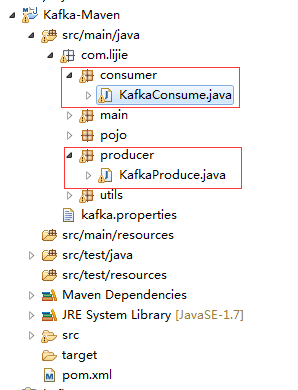溫馨提示×
您好,登錄后才能下訂單哦!
點擊 登錄注冊 即表示同意《億速云用戶服務條款》
您好,登錄后才能下訂單哦!
小編給大家分享一下kafka生產者和消費者的javaAPI怎么用,相信大部分人都還不怎么了解,因此分享這篇文章給大家參考一下,希望大家閱讀完這篇文章后大有收獲,下面讓我們一起去了解一下吧!
寫了個kafka的java demo 順便記錄下,僅供參考
1.創建maven項目
目錄如下:

2.pom文件:
<project xmlns="http://maven.apache.org/POM/4.0.0" xmlns:xsi="http://www.w3.org/2001/XMLSchema-instance"
xsi:schemaLocation="http://maven.apache.org/POM/4.0.0 http://maven.apache.org/xsd/maven-4.0.0.xsd">
<modelVersion>4.0.0</modelVersion>
<groupId>Kafka-Maven</groupId>
<artifactId>Kafka-Maven</artifactId>
<version>0.0.1-SNAPSHOT</version>
<dependencies>
<dependency>
<groupId>org.apache.kafka</groupId>
<artifactId>kafka_2.11</artifactId>
<version>0.10.1.1</version>
</dependency>
<dependency>
<groupId>org.apache.hadoop</groupId>
<artifactId>hadoop-common</artifactId>
<version>2.2.0</version>
</dependency>
<dependency>
<groupId>org.apache.hadoop</groupId>
<artifactId>hadoop-hdfs</artifactId>
<version>2.2.0</version>
</dependency>
<dependency>
<groupId>org.apache.hadoop</groupId>
<artifactId>hadoop-client</artifactId>
<version>2.2.0</version>
</dependency>
<dependency>
<groupId>org.apache.hbase</groupId>
<artifactId>hbase-client</artifactId>
<version>1.0.3</version>
</dependency>
<dependency>
<groupId>org.apache.hbase</groupId>
<artifactId>hbase-server</artifactId>
<version>1.0.3</version>
</dependency>
<dependency>
<groupId>org.apache.hadoop</groupId>
<artifactId>hadoop-hdfs</artifactId>
<version>2.2.0</version>
</dependency>
<dependency>
<groupId>jdk.tools</groupId>
<artifactId>jdk.tools</artifactId>
<version>1.7</version>
<scope>system</scope>
<systemPath>${JAVA_HOME}/lib/tools.jar</systemPath>
</dependency>
<dependency>
<groupId>org.apache.httpcomponents</groupId>
<artifactId>httpclient</artifactId>
<version>4.3.6</version>
</dependency>
</dependencies>
<build>
<plugins>
<plugin>
<groupId>org.apache.maven.plugins</groupId>
<artifactId>maven-compiler-plugin</artifactId>
<configuration>
<source>1.7</source>
<target>1.7</target>
</configuration>
</plugin>
</plugins>
</build>
</project>3.kafka生產者KafkaProduce:
package com.lijie.producer;
import java.io.File;
import java.io.FileInputStream;
import java.util.Properties;
import org.apache.kafka.clients.producer.Callback;
import org.apache.kafka.clients.producer.KafkaProducer;
import org.apache.kafka.clients.producer.ProducerRecord;
import org.apache.kafka.clients.producer.RecordMetadata;
import org.slf4j.Logger;
import org.slf4j.LoggerFactory;
public class KafkaProduce {
private static Properties properties;
static {
properties = new Properties();
String path = KafkaProducer.class.getResource("/").getFile().toString()
+ "kafka.properties";
try {
FileInputStream fis = new FileInputStream(new File(path));
properties.load(fis);
} catch (Exception e) {
e.printStackTrace();
}
}
/**
* 發送消息
*
* @param topic
* @param key
* @param value
*/
public void sendMsg(String topic, byte[] key, byte[] value) {
// 實例化produce
KafkaProducer<byte[], byte[]> kp = new KafkaProducer<byte[], byte[]>(
properties);
// 消息封裝
ProducerRecord<byte[], byte[]> pr = new ProducerRecord<byte[], byte[]>(
topic, key, value);
// 發送數據
kp.send(pr, new Callback() {
// 回調函數
@Override
public void onCompletion(RecordMetadata metadata,
Exception exception) {
if (null != exception) {
System.out.println("記錄的offset在:" + metadata.offset());
System.out.println(exception.getMessage() + exception);
}
}
});
// 關閉produce
kp.close();
}
}4.kafka消費者KafkaConsume:
package com.lijie.consumer;
import java.io.File;
import java.io.FileInputStream;
import java.util.HashMap;
import java.util.List;
import java.util.Map;
import java.util.Properties;
import org.apache.htrace.fasterxml.jackson.databind.ObjectMapper;
import com.lijie.pojo.User;
import com.lijie.utils.JsonUtils;
import kafka.consumer.ConsumerConfig;
import kafka.consumer.ConsumerIterator;
import kafka.consumer.KafkaStream;
import kafka.javaapi.consumer.ConsumerConnector;
import kafka.serializer.StringDecoder;
import kafka.utils.VerifiableProperties;
public class KafkaConsume {
private final static String TOPIC = "lijietest";
private static Properties properties;
static {
properties = new Properties();
String path = KafkaConsume.class.getResource("/").getFile().toString()
+ "kafka.properties";
try {
FileInputStream fis = new FileInputStream(new File(path));
properties.load(fis);
} catch (Exception e) {
e.printStackTrace();
}
}
/**
* 獲取消息
*
* @throws Exception
*/
public void getMsg() throws Exception {
ConsumerConfig config = new ConsumerConfig(properties);
ConsumerConnector consumer = kafka.consumer.Consumer
.createJavaConsumerConnector(config);
Map<String, Integer> topicCountMap = new HashMap<String, Integer>();
topicCountMap.put(TOPIC, new Integer(1));
StringDecoder keyDecoder = new StringDecoder(new VerifiableProperties());
StringDecoder valueDecoder = new StringDecoder(
new VerifiableProperties());
Map<String, List<KafkaStream<String, String>>> consumerMap = consumer
.createMessageStreams(topicCountMap, keyDecoder, valueDecoder);
KafkaStream<String, String> stream = consumerMap.get(TOPIC).get(0);
ConsumerIterator<String, String> it = stream.iterator();
while (it.hasNext()) {
String json = it.next().message();
User user = (User) JsonUtils.JsonToObj(json, User.class);
System.out.println(user);
}
}
}5.kafka.properties文件
##produce bootstrap.servers=192.168.80.123:9092 producer.type=sync request.required.acks=1 serializer.class=kafka.serializer.DefaultEncoder key.serializer=org.apache.kafka.common.serialization.ByteArraySerializer value.serializer=org.apache.kafka.common.serialization.ByteArraySerializer bak.partitioner.class=kafka.producer.DefaultPartitioner bak.key.serializer=org.apache.kafka.common.serialization.StringSerializer bak.value.serializer=org.apache.kafka.common.serialization.StringSerializer ##consume zookeeper.connect=192.168.80.123:2181 group.id=lijiegroup zookeeper.session.timeout.ms=4000 zookeeper.sync.time.ms=200 auto.commit.interval.ms=1000 auto.offset.reset=smallest serializer.class=kafka.serializer.StringEncoder
以上是“kafka生產者和消費者的javaAPI怎么用”這篇文章的所有內容,感謝各位的閱讀!相信大家都有了一定的了解,希望分享的內容對大家有所幫助,如果還想學習更多知識,歡迎關注億速云行業資訊頻道!
免責聲明:本站發布的內容(圖片、視頻和文字)以原創、轉載和分享為主,文章觀點不代表本網站立場,如果涉及侵權請聯系站長郵箱:is@yisu.com進行舉報,并提供相關證據,一經查實,將立刻刪除涉嫌侵權內容。